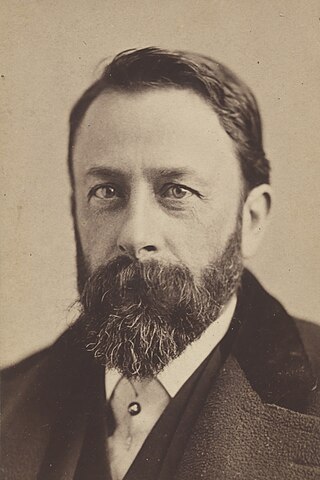
Albert Bierstadt was a German American painter best known for his lavish, sweeping landscapes of the American West. He joined several journeys of the Westward Expansion to paint the scenes. He was not the first artist to record the sites, but he was the foremost painter of them for the remainder of the 19th century.

The Hudson River School was a mid-19th-century American art movement embodied by a group of landscape painters whose aesthetic vision was influenced by Romanticism. Early on, the paintings typically depicted the Hudson River Valley and the surrounding area, including the Catskill, Adirondack, and White Mountains.

Mount Bierstadt is a 14,065-foot-high (4,287 m) mountain summit in the Front Range of the Rocky Mountains, in the U.S. state of Colorado. The fourteener is located in the Mount Evans Wilderness of Pike National Forest, 9.4 miles (15.1 km) south by east of the Town of Georgetown in Clear Creek County. It was named in honor of Albert Bierstadt, an American landscape painter who made the first recorded summit of the mountain in 1863.
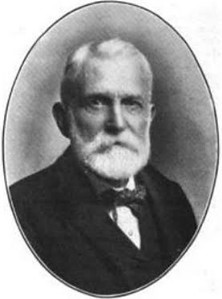
Edward Bierstadt was a photographer of portraits and landscapes as well as an engraver and a pioneer of color photography in the United States.
Gordon Hendricks (1917–1980) was an American art and film historian.

In 1859 Albert Bierstadt accompanied Frederick W. Lander on a western expedition. On his return he painted a mountain landscape on a large 6-by-10-foot (1.8-by-3.0-meter) canvas, The Rocky Mountains, Lander's Peak. Following the death of General Lander during the Civil War in 1862, Bierstadt named the peak Lander's Peak. The painting was completed in 1863 and sold in 1865 for $25,000.

Francis Seth Frost (1825–1902) or F.S. Frost was a painter, photographer, and businessman specializing in artists' materials. Based in Boston, Massachusetts, he travelled widely in the United States. Friends included Albert Bierstadt. Frost kept an art studio in the Studio Building on Tremont Street in Boston. In 1869 with E.H. Adams he began the artists' supply firm, Frost & Adams, which flourished into the 20th century.

The Rocky Mountains, Lander's Peak is an 1863 landscape oil painting by the German-American painter Albert Bierstadt. It is based on sketches made during Bierstadt's travels with Frederick W. Lander's Honey Road Survey Party in 1859. The painting shows Lander's Peak in the Wyoming Range of the Rocky Mountains, with an encampment of Native Americans in the foreground. It has been compared to, and exhibited with, The Heart of the Andes by Frederic Edwin Church. Lander's Peak immediately became a critical and popular success and sold in 1865 for $25,000.

Looking Down the Yosemite Valley, California is an 1865 painting by the German-American painter Albert Bierstadt (1830–1902).
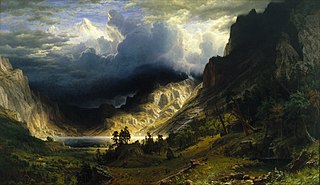
A Storm in the Rocky Mountains, Mt. Rosalie is an 1866 landscape oil painting by German-American painter Albert Bierstadt (1830-1902) which was inspired by sketches created on an 1863 expedition.
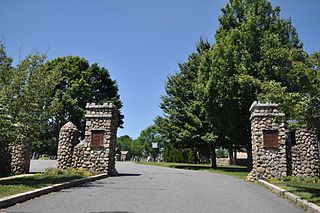
The Rural Cemetery and Friends Cemetery are a pair of connected cemeteries at 149 Dartmouth Street in New Bedford, Massachusetts United States. They occupy an irregular parcel of land more than 90 acres (36 ha) in size on the west side of the city. Established in 1837, the Rural Cemetery was the fifth rural cemetery in the nation, after Mount Auburn Cemetery, Mount Hope Cemetery, Mount Pleasant Cemetery, and Laurel Hill Cemetery. In its early days it was criticized as lacking some of the natural beauty afforded by rolling terrain; the early sections were laid out in rectilinear manner on relatively flat terrain. The cemetery was a popular burial site, including notably the landscape artist Albert Bierstadt and Governor of Massachusetts John H. Clifford.
Bierstadt is a borough in Wiesbaden, Hesse, Germany. Bierstadt may also refer to:

Bierstadt Lake is located in Larimer County, Colorado and within the Rocky Mountain National Park. Near McHenrys Peak and Longs Peak, there are "spectacular views" of the Continental Divide at the lake. The Bierstadt Lake Trailhead is located about 6.5 miles (10.5 km) from the turn-off at U.S. Route 36 into the Rocky Mountain National Park. During the summer, shuttle buses provide transportation to the trailhead.

Mount Hood is an 1869 painting by Albert Bierstadt, and part of the collection of the Portland Art Museum in Portland, Oregon, in the United States. It portrays a view of the mountain in Oregon with the same name.

Valley of the Yosemite is a painting by the German American painter Albert Bierstadt that was completed in 1864. Initially associated with the Hudson River School, Bierstadt rose to prominence for his paintings of the Rocky Mountains, which established him as one of the best painters of the western American landscape. His later paintings of Yosemite were also received with critical acclaim and public praise.

The Falls of St. Anthony is an 1880 oil landscape painting by the Hudson River School artist Albert Bierstadt.
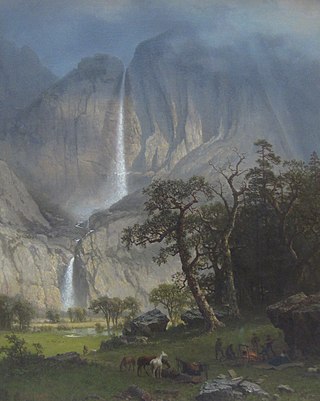
Cho-looke, the Yosemite Fall is an 1864 oil painting on canvas by the German American painter Albert Bierstadt.

Among the Sierra Nevada, California is an 1868 oil-on-canvas painting by German-American artist Albert Bierstadt which depicts a landscape scene of the Sierra Nevada mountain range in California. Created at his studio in Rome, the painting was exhibited throughout Europe, creating interest in immigration to the United States. Measuring 72 by 120+1⁄8 inches, the painting is a centerpiece of the 19th-century landscape collection at the Smithsonian American Art Museum in Washington, D.C.

The American Pre-Raphaelites was a movement of landscape painters in the United States during the mid-19th century. It was named for its connection to the Pre-Raphaelite Brotherhood and for the influence of John Ruskin on its members. Painter Thomas Charles Farrer led the movement, and many members were active abolitionists. Their work together was short-lived, and the movement had mostly dissolved by 1870.

















